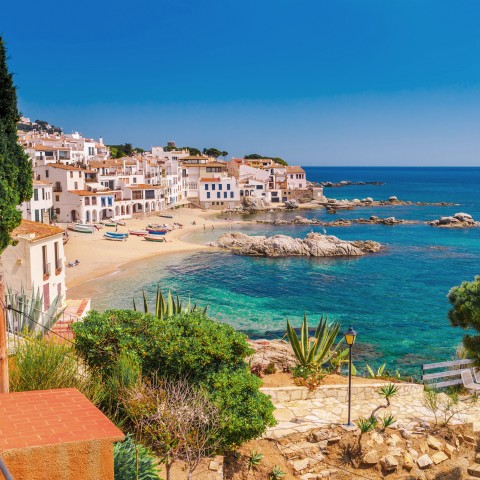We’ve all encountered this typical situation: You’re getting back home after a long day. You’re tired and are finally inside the elevator, going up to your place. You’re going to the top floor, the elevator stops, and then someone quickly walks inside and the door closes.
Oh no!
“Hi!” you say.
“Hello” says your neighbour back to you.
You both look at each other, he smiles…Oh, no! Uncomfortable situation! Eight floors away from your house and it’s like forever.
Suddenly he says “It’s very cloudy out there. It says that tomorrow it may rain.”
Aha! Weather! It’s always the perfect subject to bring up inside the elevator.
If you find yourself in that situation in Spain, you have to be prepared to break the ice by learning about the Spanish weather phrases, vocabulary, and more. Learn weather expressions in Spanish in this article, and then check out our article about the many ways to say Hello in Spanish.
Table of Contents
- The Most Common Vocabulary for Talking about Climate in Spanish
- Spanish Weather Terms and Phrases
- Spain Weather
- Saying the Temperature in Spanish
- The Most Common Ways to Comment on the Weather in Spanish
- Conclusion
1. The Most Common Vocabulary for Talking about Climate in Spanish
Nouns
Spanish weather terms for talking about the weather can be masculine or feminine. Spanish is a gendered language, and you can tell if a noun is masculine or feminine based on the article preceding it: -el [m.] or -la [f.].
To learn more about how to use feminine and maculine nouns, you should make sure to learn the Spanish articles that go with them. You can get a head start by checking out our list of the fifty most common Spanish nouns.
There are some words in this list that you can use as adjectives, so be careful how you use them.
- El sol — “The sun”
Esta mañana salió el sol a las 7 a.m.
“This morning, the sun rose at seven a.m.”
- La nieve — “The snow”
Ten cuidado, que la nieve está resbaladiza.
“Be careful, the snow is slippery.”
- La brisa — “The breeze”
Dicen que la brisa del mar es buenísima para la piel.
“It’s been said that the sea breeze is very good for your skin.”
- Las nubes — “The clouds”
Hay demasiadas nubes para ir a la playa.
“There are too many clouds to go to the beach.”
- La lluvia — “The rain”
La lluvia es imprescindible para la agricultura.
“Rain is indispensable for agriculture.”
- La tormenta — “The storm”
La tormenta del jueves se llevó algunas casas del río.
“The storm on Thursday took away some houses in the river.”
- El viento — “The wind”
El viento es suave en la costa.
“The wind is soft around the coast.”
- El frío — “The cold”
El frío es más seco en el interior que en la costa.
“The cold is drier in the inland than at the coast.”
- El calor — “The heat”
Prefiero el calor al frío.
“I prefer the heat to the cold.”
- El granizo — “The hail”
El granizo de anoche rompió el cristal de mi coche.
“The hail last night broke my car’s glass.”
- La humedad — “The humidity”
Hay mucha humedad en Málaga hoy.
“There’s a lot of humidity in Malaga today.”
- El trueno — “The thunder”
Los truenos asustan a mi gato.
“Thunders scare my cat.”
- El relámpago — “The lightning strike”
Los relámpagos son preciosos para fotografiar.
“The lightning strike is beautiful to photograph.”
- El rayo — “The lightning bolt”
Casi me cae un rayo.
“I almost got hit by a lightning bolt.”
Adjectives
If you’re learning Spanish, you should try to learn plenty of Spanish adjectives because they provide more information about the different types of weather in Spanish, whether you’re in the north where it’s cold or in the south where it’s hot.
Here are some examples of adjectives about the weather in Spanish and English.
- Caluroso — “Hot”
Hace un día caluroso.
“It is a hot day.”
- Soleado — “Sunny”
Prefiero los días soleados en la costa.
“I prefer sunny days by the cost.”
- Despejado — “Clear skies”
El cielo está despejado.
“The skies are clear.”
- Húmedo — “Humid”
El día está muy húmedo hoy.
“Today is a very humid day.”
- Lluvioso — “Rainy”
Me encanta leer en los días lluviosos.
“I love to read during rainy days.”
- Frío — “Cold”
Mi hermano prefiere ciudades frías para vivir.
“My brother prefers cold cities to live.”
- Fresco — “Cool”
En verano salgo a la calle cuando está fresco.
“In summer I go out when it’s cool.”
- Helado — “Freezing”
En Inglaterra el invierno es helado.
“In England, winter is freezing.”
- Nublado — “Cloudy”
En Inglaterra siempre está el día nublado.
“In England, the days are always cloudy.”
- Gris — “Gray”
A mi hermana le gustan los días grises para salir a correr.
“My sister likes gray days to go running.”
- Ventoso — “Windy”
A mi perro no le gustan los días ventosos.
“My dog does not like windy days.”
Now, let’s look at some Spanish verbs about the weather to complete the sentence. These Spanish verbs for talking about weather and climate in Spanish are always used in the third person. Let’s look at some examples.
Verbs
- Llover — “To rain”
Esta primavera está lloviendo mucho en Galicia.
“This spring it’s raining a lot in Galicia.”
- Nevar — “To snow”
Va a nevar este invierno en Barcelona.
“It is going to snow this winter in Barcelona.”
- Chispear — “To drizzle”
Está chispeando hoy.
“It is drizzling today.”
- Granizar — “To hail”
No llueve granizo en el sur de España.
“It does not hail in the south of Spain.”
2. Spanish Weather Terms and Phrases
Knowing about the weather in Spain before traveling is essential because your experience can change depending on the seasons in Spain. From a rainy day to a very hot one—or even worse, a humid day—the weather can impact so many aspects of your visit. So if you have a Spanish friend, ask him/her before booking your flight.
Here are the basics for asking about weather in Spanish:
- ¿Qué tiempo hace?
“What is the weather like?”
You may also ask:
- ¿Cómo está el tiempo?
“How is the weather?”
Here are a couple more ways you can ask about the weather in Spanish:
- ¿Cómo está el clima?
“How’s the weather/climate?” - ¿Qué tiempo hace fuera?
“What’s it like outside?”
The first two questions are more common, but you can use the last ones as well, especially in writing.
To reply, you can always decide to use one of the two main Spanish verbs: Estar or Hacer.
Let’s see how.
Estar — “To be”
- ¿Cómo está el tiempo?
“How is the weather?” - Está nublado.
“It is cloudy.”
Hacer — “Make” or “Do”
Although its literal translation in English is “to make” or “to do,” in Spanish you can still use this verb to mean “to be.”
Let’s see some examples.
- ¿Qué tiempo hace en Madrid?
“What is the weather like in Madrid?” - Hace mucho frío.
“It is very cold.”
The Spanish weather term tiempo means different things depending on the context. We use tiempo to talk about time as well as to talk about the weather.
- Time
No me da tiempo llegar a casa para comer.
“I don’t have time to get home for lunch.”
- Weather
¿Cómo está el tiempo en Sevilla, España?
“How is the weather in Seville, Spain?”
3. Spain Weather
Spain is well-known for its weather, and Spain’s climate plays an important role in its culture and economy. This is because, generally, the south is the home of eternal sunshine, hot summers, and chilly winters; the north is known for its cold, windy, and wet summers.
The weather in Barcelona is the perfect combination. The Catalan capital has a fresh climate all year long. The hottest month is August at about 30 degrees Celsius (86 degrees Fahrenheit) and the coldest month is January at around 12 degrees Celsius (53.6 degrees Fahrenheit).
Madrid is what we call interior, inland, or central Spain. Due to its altitude where the seaside is miles away, the capital of Spain has chilly winters and scorching summers with intense heat. Does it snow in Spain? Yes, winter in Madrid may come with some snow.
If you want to enjoy the capital of Spain, you should visit between those cold winters and the summer heat.
The south of Spain, the area of Andalusia, is considered one of Europe’s hottest destinations all year round. However, the weather in Seville can be extremely hot during the summertime. It doesn’t snow in Seville, as the weather of southern Spain is perfect all year long.
Seville, Cordoba, and Málaga are very famous cities in the south due to their weather.
4. Saying the Temperature in Spanish
When talking about the weather in Spanish, you may be asked about the temperature. The weather is a very important part of Spanish culture, which is why you should also know that Spanish speakers use Celsius instead of Fahrenheit.
The weather in Seville is about 30 degrees, which is quite hot, though the temperature can get as low as 10 degrees during the winter.
The weather in Madrid, on the other hand, can get as low as 2 degrees.
Wherever you are, to talk about the weather in Spanish you should use the verb estar, meaning “to be,” and the verb hacer, meaning “to make” or “to do.”
The Most Common Sentence Patterns for Talking about Weather in Spanish
To talk about the weather in Spanish, sometimes you have to use the verb haber, which translates to “there is” and “there are.” For example, Hay niebla means “It’s foggy,” though it literally means “There is fog.”
Sometimes you have to use the verb estar, which in English is the verb “to be.” Although in English, you would always use the verb “to be” for talking about the weather, in Spanish you have to know when to use estar or haber.
Let’s see some examples.
Estar — “To be” + [adjective]
- ¡Hace calor hoy!
“It’s hot today!”
To answer, the formula is:
Hacer — “To do” + [number of degrees]
- Sí, hace 30 grados hoy.
“Yes, it is 30 degrees today.”
Or
- Hace mucha humedad hoy.
“It is very humid today.”
What if it’s cold outside?
¡Qué frío! Estamos a 2 grados hoy.
Or
¡Qué frío! Hace 2 grados hoy.
These translate to: “It’s so cold! It’s 2 degrees today.”
5. The Most Common Ways to Comment on the Weather in Spanish
So let’s go back to the ice breaker conversation in the elevator. When discussing weather in Spanish, this is how it may sound:
A: ¡Hola!
A: “Hello!”
B: Hace mucho calor hoy, ¿no?
B: “It’s very hot today, isn’t it?”
A: Sí, estamos a 25 grados.
A: “Yes, it is 25 degrees.”
B: Pero bajará la temperatura este otoño.
B: “But the temperature will go down in the fall.”
A: No sé, el pronóstico dice que seguirán los días soleados hasta invierno.
A: “I don’t know, the forecast just said that we may continue to have sunny days until winter.”
B: Sí, pero hay muchas nubes grises, quizá llueva mañana.
B: “Yes, but we have gray clouds, it may rain tomorrow.”
A: Sí, debería llover, hace mucho calor aún.
A: “Yes, it should rain, because it is still very hot.”
B: Sí, y mucha humedad.
B: “Yes, and it is very humid.”
A: Bueno, puede que llueva.
A: “Well, it may rain.”
6. Conclusion
Knowing some Spanish weather expressions, phrases, and vocabulary may help you loads. This is because no matter the language you’re learning, the weather will always be a great conversation starter.
It’s very important that you know the main vocabulary so you can practice. For that, SpanishPod101 has many great learning tools so you can start speaking today and improve your Spanish skills over time. In Learn Spanish, we have all the tools you need, regardless of your current level, so you can bring your skills and fluency to one-hundred percent! Have you already tried?
What’s the weather like where you are? Write us a comment in Spanish to let us know; we look forward to hearing from you!

















